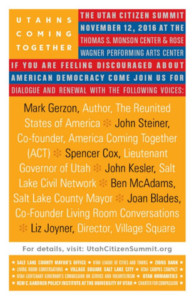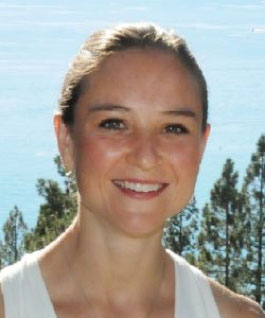By Heather Gilmartin Adams for EDRblog.org.
On Saturday, November 12, the first Utah Citizens Summit was held in downtown Salt Lake City. The event – a day of dialogue and celebration sponsored by the Utah Civil and Compassionate Communities Initiative – capped a yearlong effort to bring communities together through conversation and service. Organizers and participants designed the summit “to be a catalytic event in bringing Utahns and Americans together around our highest shared principles and connecting with communities and groups across the nation who wish to illuminate and interconnect each other’s efforts and participate in a learning and action community together.”
 The summit was innovative, inspiring, and valuable in a number of ways. But one theme in particular resonated with me: the idea of getting “below the surface” to establish human-to-human connections as a foundation for collaboration. While not a stated theme of the event, this idea seemed to thread through the agenda, topics of conversation, language, and personal energies of the event participants.
The summit was innovative, inspiring, and valuable in a number of ways. But one theme in particular resonated with me: the idea of getting “below the surface” to establish human-to-human connections as a foundation for collaboration. While not a stated theme of the event, this idea seemed to thread through the agenda, topics of conversation, language, and personal energies of the event participants.
Image credit: Utah Citizens Summit
These human-to-human connections are one of the most important parts of the work we do – one of the biggest values that we as facilitators in this field can bring to the mix. In my work, we often talk about people as icebergs: there’s a lot more going on under the surface than we can see. When you get down to the level of needs and fears, a handful of shared elements comprise the core of much of the human experience. For example, the need for a sense of belonging or the fear of rejection. We all share these needs and fears to some degree. When we see these same elements in “those people” and “the other,” we start to understand and identify with them – we recognize our shared humanity. This helps us to connect as humans, even as we disagree on policies or reject specific behaviors. This is why, in our workshops, my colleagues and I talk about holding difficult conversations from a “person-to-person” perspective.
Get notified when new articles are posted to the EDR blog – sign up for our email list »
This idea of getting below the surface shows up in the work of collaborative problem solving and dispute resolution in various ways. For example, effective negotiation relies on moving people from positions (the “what” I want) to underlying interests (the “why” behind my positions – what it is that really matters to me and the people I represent). Transformative mediation often identifies shared needs and values as the foundation for a new relationship, which can help people productively address conflict. Such approaches can help people better understand where others are coming from, appreciate our shared humanity, and work through differences.
I believe these human-to-human connections are an absolutely critical part of healing the divides that have recently come into such stark relief in our communities and nation. And the Utah Citizens Summit models this approach beautifully. Participants at the summit came from a variety of religious, political, and racial backgrounds. From the outset, the summit organizers and participants made explicit, that despite their differences, they would use the shared values of civility, compassion, inclusivity, and collaboration as a platform for working and dialoguing together.
In the actual dialogues, more specific examples of these connections came through. One of the event sponsors, Living Room Conversations, was founded specifically to convene people with different points of view to have structured but informal conversations on difficult topics. Mark Gerzon, in his keynote address, described recent conversations with people from all across the political spectrum. He asked these individuals to reflect on why they were behaving (especially voting) in the way they were, then dug below the surface of their answers with further questions. He uncovered an underlying theme of a love for country: “I love the USA.” He highlighted this shared love – which manifests in extremely different ways for different people – as a basis for moving forward.
I greatly appreciated that the summit not only modeled the importance of human-to-human connections, but also explored practical ways we can facilitate these connections on a regular basis. There are tons of organizations out there bringing people together in a variety of ways. Here are a few mentioned at the event:
- Bridge Alliance http://www.bridgealliance.us/
- Living Room Conversations http://www.livingroomconversations.org/
- Village Square http://tothevillagesquare.org/
- Salt Lake Civil Network http://www.saltlakecivilnetwork.org/utah-citizen-summit/
 I encourage practitioners and citizens everywhere to investigate these resources and focus on cultivating more human-to-human connection into your work and personal life. Given the environmental, economic, cultural, and political challenges we will face in our communities in the coming years and decades, it is now more important than ever to come together to build a shared sense of our fundamental commonalities.
I encourage practitioners and citizens everywhere to investigate these resources and focus on cultivating more human-to-human connection into your work and personal life. Given the environmental, economic, cultural, and political challenges we will face in our communities in the coming years and decades, it is now more important than ever to come together to build a shared sense of our fundamental commonalities.
Heather Gilmartin Adams is a consultant and engagement manager for Co-Creation Partners, an organizational culture transformation consultancy. With an educational background in international peacebuilding, she loves working at the nexus of organizational culture, personal transformation and conflict resolution. She holds degrees from Columbia and Princeton Universities.
